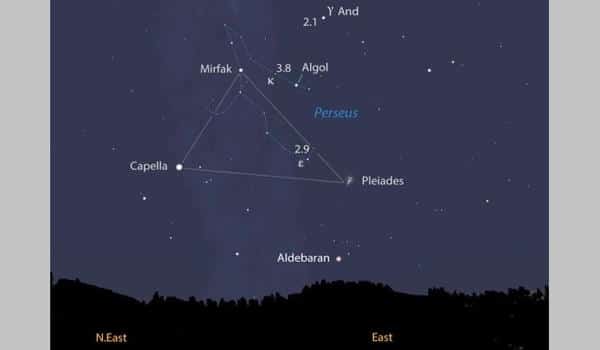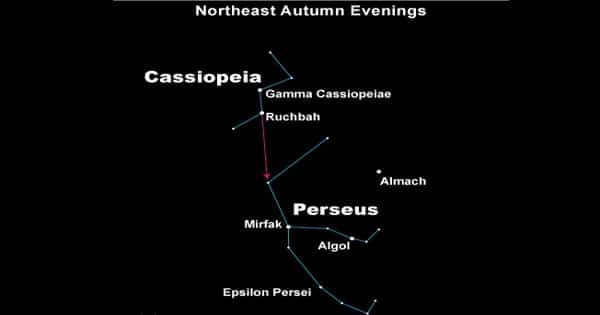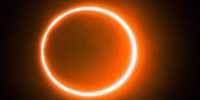Algol, the second brightest star in the northern constellation Perseus, is the best example of an eclipsing variable star in the entire sky. In this compact stellar system, two stars revolve around their common center of mass in a rhythmic and precise gravitational dance, and the resulting eclipse causes the brightness of the star to vary like clockwork to a degree that is easily perceptible to the human eye. And you can watch it from your own backyard. No need for a telescope.
Algol, also known as Beta Persei, is located 93 light years away from Earth. It’s a binary, like many stars: a hot blue-white main sequence star about three times the diameter of our Sun, and a cooler yellow-orange star that’s begun to grow long in the tooth. Because they are so close to each other, only one-twentieth the distance between the Earth and the Sun, they revolve quickly, once every 2.867 days to be exact. Such binary stars with such close spacing are quite common.
However, unlike many binary stars, Algol’s orbital plane is aligned with our point of view, so the fainter cool star partially blocks the brighter hot star once per revolution. As a result, the total brightness of the two stars appears to drop abruptly by roughly 70%. When the brighter star obscures the cool star, the total brightness decreases again, but by a much smaller amount over the same time period.
Algol, the second brightest star in the northern constellation Perseus, is the finest example of an eclipsing variable star in the entire sky.
Algol frightened ancient stargazers, possibly due to its rhythmic changes in brightness. Its name is derived from the Arabic al Ghul, which means “the Demon,” and in Greek mythology, Algol represents the head of Medusa, the snake-haired gorgon whose head Perseus used to turn the sea monster Cetus to stone. Algol was also thought to represent misfortune by the ancients. In the Iliad, Homer described Algol as “…the Gorgon’s head, a ghastly sight, deformed and dreadful, and a sight of woe.”
However, the star received a bad rap from the ancients. In the 17th and 18th centuries, as modern science advanced, astronomers were able to make more precise measurements of Algol’s brightness variations. Some astronomers hypothesized that the variability was caused by an eclipse, possibly caused by a large planet orbiting the star. Finally, with the development of spectroscopy in the late nineteenth century, astronomers were able to confirm the existence of two stars that revolved around each other, one fainter than the other. A much fainter third star was discovered in the system over time; this star revolves around the two brighter stars every 1.85 years.

All three stars are too close to each other to be resolved directly in a telescope, in our opinion. However, clever interferometric imaging schemes have resolved the two main stars and demonstrated their revolution.
You can see Algol in action here. It can be found in Perseus, just east of Mirfak, the brightest star in the constellation. When not in eclipse, the star has a magnitude of 2.2. When the fainter component partially eclipses the brighter component at maximum eclipse, the brightness drops noticeably to magnitude 3.3. The eclipse lasts about ten hours, from maximum to minimum to maximum again, so if you time it correctly, you can see the brightness fall and rise in a single night and a noticeable change in brightness in just a couple of hours. You can track the eclipse’s progress by comparing the brightness of the Algol to nearby Epsilon (ε) Persei (magnitude 2.9) and Gamma (γ) Andromedae (Almaak), which is magnitude 2.1. There is no need for a telescope once more.
As previously stated, Algol eclipses occur every 2.867 days. This page has a useful predictor tool for Algol and several other bright variable stars, so you can find out when they will appear in your time zone.
A light curve is formed when the brightness (or magnitude) of a variable star, such as Algol, is measured. The distinctive light curve shown below is produced by an eclipsing variable. The deep brightness drop occurs when the faint star obscures the bright star. When a bright star blocks a faint star, the brightness dips more shallowly.
Eclipsing binary stars like Algol are more than just a passing fad. They also allow astronomers to directly determine stellar brightness and mass, which aids in the refinement of theories and mathematical models of how stars work. It’s yet another example of how nature can be generous: we can measure the true size and brightness of a star trillions of miles away simply by careful observation and deduction, and use these measurements to infer the properties of thousands of other stars. Science is a wonderful thing.















